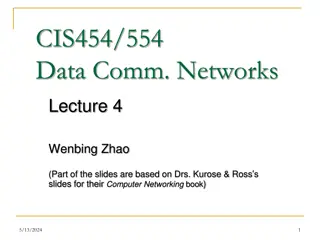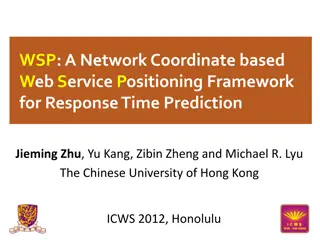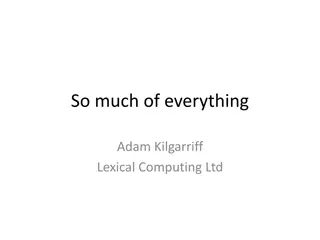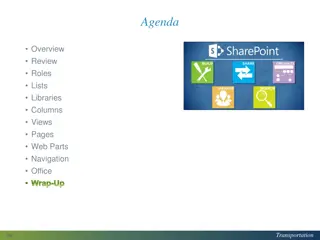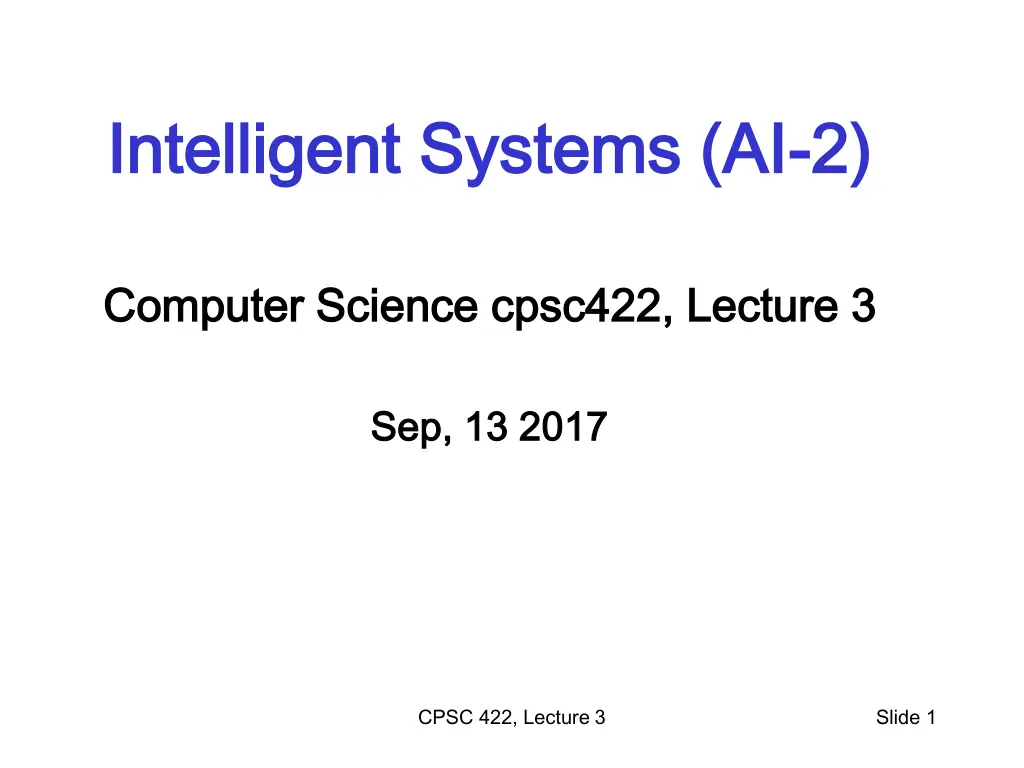
Stochastic Planning and Markov Decision Processes Overview
Explore the world of intelligent systems and AI through lectures on Markov Decision Processes, Formal Specifications, Optimal Policies, and more. Delve into the limitations of decision networks, advantages of Markov models, and the management of ongoing decision processes. Learn about Markov Chains, Partially Observable Markov Decision Processes, and how to handle indefinite and infinite decision processes effectively.
Download Presentation

Please find below an Image/Link to download the presentation.
The content on the website is provided AS IS for your information and personal use only. It may not be sold, licensed, or shared on other websites without obtaining consent from the author. If you encounter any issues during the download, it is possible that the publisher has removed the file from their server.
You are allowed to download the files provided on this website for personal or commercial use, subject to the condition that they are used lawfully. All files are the property of their respective owners.
The content on the website is provided AS IS for your information and personal use only. It may not be sold, licensed, or shared on other websites without obtaining consent from the author.
E N D
Presentation Transcript
Intelligent Systems (AI Intelligent Systems (AI- -2) 2) Computer Science Computer Science cpsc422 cpsc422, Lecture 3 , Lecture 3 Sep, 13 2017 Sep, 13 2017 CPSC 422, Lecture 3 Slide 1
Lecture Overview Lecture Overview Markov Decision Markov Decision Processes Formal Specification and example Policies and Optimal Policy Intro to Value Iteration Processes CPSC 422, Lecture 3 2
Combining ideas for Stochastic planning Combining ideas for Stochastic planning What is a key limitation of decision networks? Represent (and optimize) only a fixed number of Represent (and optimize) only a fixed number of decisions decisions What is an advantage of Markov models? The network can extend indefinitely The network can extend indefinitely Goal: represent (and optimize) an indefinite Goal: represent (and optimize) an indefinite sequence of decisions sequence of decisions CPSC 422, Lecture 2 Slide 3
Decision Processes Decision Processes Often an agent needs to go beyond a fixed set of decisions Examples? Would like to have an ongoing decision process ongoing decision process Infinite horizon problems Infinite horizon problems: process does not stop Indefinite horizon problem: Indefinite horizon problem: the agent does not know when the process may stop Finite horizon Finite horizon: the process must end at a give time N CPSC 422, Lecture 2 Slide 4
Markov Models Markov Models Markov Chains Hidden Markov Model Partially Observable Markov Decision Processes (POMDPs) Markov Decision Processes (MDPs) CPSC 422, Lecture 3 Slide 5
Summary Decision Processes: MDPs Summary Decision Processes: MDPs To manage an ongoing (indefinite infinite) decision process, we combine . Markovian Stationary Utility not just at the end Sequence of rewards Fully Observable CPSC 422, Lecture 3 Slide 6
Example MDP: Scenario and Actions Example MDP: Scenario and Actions Agent moves in the above grid via actions Up, Down, Left, Right Each action has: 0.8 probability to reach its intended effect 0.1 probability to move at right angles of the intended direction If the agents bumps into a wall, it says there How many states? There are two terminal states (3,4) and (2,4) CPSC 422, Lecture 3 Slide 7
Example MDP: Rewards Example MDP: Rewards CPSC 422, Lecture 3 Slide 8
Example MDP: Underlying info structures Example MDP: Underlying info structures Four actions Up, Down, Left, Right Eleven States: {(1,1), (1,2) (3,4)} 2,1 CPSC 422, Lecture 3 Slide 9
Example MDP: Sequence of actions Example MDP: Sequence of actions Can the sequence [Up, Up, Right, Right, Right ] take the agent in terminal state (3,4)? Can the sequence reach the goal in any other way? CPSC 422, Lecture 3 Slide 10
MDPs: Policy MDPs: Policy The robot needs to know what to do as the decision process unfolds It starts in a state, selects an action, ends up in another state selects another action . Needs to make the same decision over and over: Given the current state what should I do? So a policy for an MDP is a single decision function that specifies what the agent should do for each state s single decision function (s) CPSC 422, Lecture 3 Slide 11
How to evaluate a policy How to evaluate a policy A policy can generate a set of state sequences with different probabilities Each state sequence has a corresponding reward. Typically the (discounted) sum of the rewards for each state in the sequence CPSC 422, Lecture 3 Slide 12
MD MDPs: expected value/total reward of a policy Ps: expected value/total reward of a policy and optimal policy and optimal policy Each sequence of states (environment history) associated with a policy has a certain probability probability of occurring a given amount of total reward reward as a function of the rewards of its individual states Expected value /total reward Expected value /total reward For all the sequences of states generated by the policy Optimal policy Optimal policy is the policy that maximizes expected total reward Slide 13 CPSC 422, Lecture 3
Lecture Overview Lecture Overview Markov Decision Processes Formal Specification and example Policies and Optimal Policy Intro to Value Iteration Intro to Value Iteration CPSC 422, Lecture 3 14
Discounted Reward Function Discounted Reward Function Suppose the agent goes through states s1, s2,...,sk and receives rewards r1, r2,...,rk We will look at discounted reward discounted reward to define the reward for this sequence, i.e. its utility for the agent discount factor , 0 1 bound max on R(s) for every R s = + + + 2 [ , , ,..] ..... U s s s r r r 1 2 3 1 2 3 R 1 = = = = i i max r R + 1 max i 0 0 i i CPSC 422, Lecture 3 Slide 15
Sketch of ideas to find the optimal policy for a Sketch of ideas to find the optimal policy for a MDP MDP(Value Iteration) We first need a couple of definitions V (s): the expected value of following policy in state s Q (s, a), where a is an action: expected value of performing a in s, and then following policy . We have, by definition Q (s, a)= reward obtained in s Probability of getting to s from s via a states reachable from s by doing a expected value of following policy in s Discount factor CPSC 422, Lecture 3 Slide 16
Value of a policy and Optimal policy Value of a policy and Optimal policy We can also compute V (s) in terms of Q (s, a) ) ( s V = ( , ( )) Q s s action indicated by in s Expected value of following in s Expected value of performing the action indicated by in s and following after that For the optimal policy * we also have = * * ( ) ( , * ( )) V s Q s s CPSC 422, Lecture 3 Slide 17
Value of Optimal policy Value of Optimal policy = * * ( ) ( , * ( )) V s Q s s Remember for any policy )) ( , ( s s Q ' s = + ( ) ( | ' s , ( )) ( ) ) ' s R s P s s V But the Optimal policy * is the one that gives the action that maximizes the future reward for each state = + * ( , * ( )) ( ) Q s s R s So s = + * * ( ) ( ) max a ( | ' s , ) ( ) ) ' s V s R s P s a V ' Slide 18 CPSC 422, Lecture 3
Value Iteration Rationale Given N states, we can write an equation like the one below for each of them = 1 ( ) ( R s V s s + ) max a ( | ' s , ) ( ) ' s s P s a V 1 1 ' = + ( ) ( ) max a ( | ' s , ) ( ) ' s V s R s P s a V 2 2 2 ' Each equation contains N unknowns the V values for the N states N equations in N variables (Bellman equations): It can be shown that they have a unique solution: the values for the optimal policy Unfortunately the N equations are non-linear, because of the max operator: Cannot be easily solved by using techniques from linear algebra Value Iteration Algorithm: Iterative approach to find the optimal policy and corresponding values CPSC 422, Lecture 3 Slide 19
Learning Goals for todays class Learning Goals for today s class You can: You can: Compute the probability distribution on states given a sequence of actions in an MDP Define a policy for an MDP Define and Justify a discounted reward function Derive the Bellman equations on which Value Iteration is based (we will likely finish this in the next lecture) CPSC 422, Lecture 3 Slide 21
TODO for TODO for Fri Fri Read textbook Read textbook 9.5.3 Value Iteration 9.5.3 Value Iteration For Fro: For Fro: CPSC 422, Lecture 3 Slide 22

